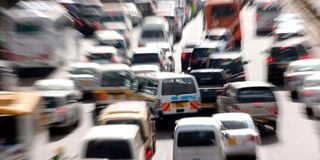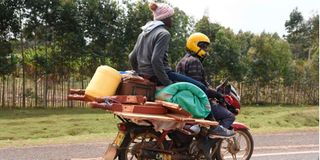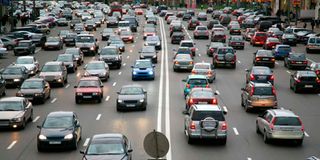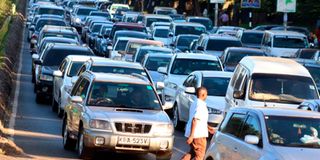Premium
We have a crisis on our roads; how do we deal with it?

Heavy traffic jam along University Way, Nairobi.
What you need to know:
- The number and shapes of bumps, everywhere, has moved from grossly excessive to downright ludicrous.
- The same time the number of vehicles has quadrupled from around half-a-million to more than two million.
Kenya’s roads and traffic have undergone huge change in the past couple of decades. We have been tarmacking and improving and extending roads on an unprecedented scale in towns and highways throughout the land. Progress has been remarkable.
And at the same time the number of vehicles has quadrupled from around half-a-million to more than two million, including an astonishing number of motorcycle taxis, the boda bodas, which have transformed the mobility of people and goods at exceptional levels of availability, flexibility and affordability.
They are not so good on manners and safety though, but while their conduct and “swarm of bees” impact may not be pretty, in addition to delivering an additional and now essential dimension of transport, they have also generated livelihoods for many millions of people.
Indeed, boda bodas (along with mobile phones), are arguably among the most life-changing features of our modern history.

A boda boda rider transports a passenger with his luggage at Cheplaskei on the Eldoret-Nakuru highway in Uasin Gishu County. Boda bodas break traffic rules with impunity.
The rate and scale of these changes could throw even the most orderly and well-resourced traffic systems into some degree of disarray. In Kenya’s socio-political and economic context, some sizeable negatives are inevitable. For example, almost all journey times have literally doubled, which has a national economic impact on productivity and costs that is somewhere between damaging, devastating and disastrous.
Policy planners and road users have coped remarkably well, and one of our options is to be grateful that the current situation is not even more chaotic. Another is to recognise that while the positives are some compensation/consolation for the downsides, they are not a solution to the increasingly negative consequences.
And that is our challenge now: not to blame or excuse the current situation, but to find the best ways to fix it. So this week’s Car Clinic takes a look at what can and can’t be done.
What is preferable?
What is possible?
What is practical?
…starting with…
What are the priorities?
There is no silver bullet solution to Kenya’s traffic problems. The fix will have to be in stages and it will take time. First, know that. Second, however fierce the current fire-fighting challenges are, any long-term project must start with an ultimate objective against which all interim measures can be designed and measured.
That bit is relatively easy. It is defined by what motorised road transport is for: the movement of people and goods from one place to another, as smoothly, swiftly, economically and safely as possible.
And it is self-evident what feature best serves all of those elements. Not difficult to remember because it is not a wheelbarrow load of research data, analysis and policy papers. It is one word: Flow.

One main cause of tailbacks on busy roads is very slow vehicles.
This is not a matter of opinion or an epiphany. It is a universal fact. It is the governing principle of virtually everything modern man does that better “flow” gets more done and more made at less cost in less time.
Mass production industry is one of the most obvious examples, but the core principle is also a certainty in virtually every aspect of business and social activity from of running an airport to… washing the dishes!
So the next steps are clear:
What are we doing to improve traffic flow – could we do more?
What are we doing that obstructs flow – could we stop doing it?
These principles need to be applied to every aspect of roads, vehicles, drivers, other road users and roadside settlements, and in regulations and administration – all measured above all (and if need be exclusively) for their impact on traffic flow.
The improvements side of the equation will involve initially heavy investment.

A traffic jam on the Eldoret-Webuye highway in January this year. The jam was caused by striking truck drivers.
These already are necessary and will become increasingly urgent, so the sooner they are addressed the better because the penalty costs of not doing them are ultimately much, much greater than the cost of doing them. But that “start now” process will always be a long-term and step-by-step process – especially hard to prioritise in an election year.
So perhaps we should set aside for now the things we need to do that cost a lot and take time, and start with things we should stop doing, things that can be “not done” that can happen very quickly and at minimal or no cost…and in that field there are some clear candidates that could make a huge difference.
In summary
On vehicles, remove or re-route slow vehicles of any size or type that cannot maintain an ambient speed of 60-80 kilometres per hour on highways.
On drivers, publish a highway code, give driving schools a mandatory syllabus, and thoroughly test that learner candidates have a full working knowledge of both. Make “adequate progress” and “the clearway principle” cardinal messages of the tuition and test processes.
On other road users, at least start to segregate some of the traffic, starting with pedestrians, livestock, handcarts, cyclists and boda bodas. Wherever possible, they should use the hard shoulder only. Run public education campaigns with that message.
On roadside settlements, educate, enforce the sanctity of road reserves, and make settlement planners accountable. Make those who want a speed bump next to them responsible for ensuring the warning signs and markings are properly protected and maintained, and immediately remove the bump if they are not.
On regulations and administration, make promotion of compliance with the foregoing measures a priority and devote enforcement resources to facilitating flow above any other issue. None of those measures costs a lot, all can be legislated and actioned almost immediately.
On roads
Stop adding speed bumps, remove most of those that are already there and make sure those that remain comply to the KS Standard. Reclaim the sanctity of road reserves and make strict observance of the “clearway” principle physically possible, with hard shoulders and road reserves that are truly “reserved” as unobstructed open space.
The number and shapes of bumps – everywhere – has moved from grossly excessive to downright ludicrous. There are now so many, mostly unmarked and illegally shaped, that this factor alone increases journey times (and fuel consumption and wear-and-tear) by at least 30 percent. That is the additional cost to one vehicle on one trip, every vehicle on every trip.
Trips vary in length and number, but take an average that 30 percent means an additional half-an-hour and three litres more fuel for every vehicle every day. Now multiply that by 2 million vehicles and multiply that by 365 days.
That is an annual penalty of 365 million wasted man hours (for just the drivers, never mind their passengers) and more than Sh200 billion (sic) of extra fuel, never mind the extra wear on tyres, brakes, clutches and suspensions.
Does that waste sound like something worth “not doing”? Consider your answer quickly – if you wait another day, that is another million man hours and another Sh720 million down the drain.
These figures are realistic. If you want to test it, try the beautifully constructed and surfaced and signposted A1 class highway from Kajiado to Sara. The first half, to Masharu, has almost no traffic but lots of speed bumps – among the most clearly signposted and marked in the whole of Kenya.

Heavy traffic along Uhuru highway. Traffic jams are time eaters that have an impact on the economy.
Count the distance, count the number of bumps, and count the number of times you brake quite hard and how many gears you change down to a near standstill, and how many you change up again as you re-accelerate to a moderate cruising speed. Measure how long it takes to get to Masharu, and how much fuel you will have consumed.
Then drive the second half to Sara which is a B2 class low-volume rural tar surface, also with almost no traffic but this time without bumps. You will hardly have to touch your brakes or your clutch or your gear lever at all. With the same top cruising speed, you will get there in much less time and consume much less fuel.
That is how I did my sums on this. The difference in time and cost per kilometre was 30 per cent. That is the order of saving that could be made by every vehicle throughout Kenya every trip every day simply by removing speed bumps.
Bear in mind that on busier roads, bumps also cause streams of traffic to concertina into tailbacks, which leads to even more delay and or a dodgems of overtaking, harsher acceleration, harsher braking. Through the resultant kinetic waves that can start many kilometres before a bump and continue for many kilometres after it.
The remedy for all this could be started immediately, would not take long and would have a minimal or manageably moderate cost.
On vehicles
The other main cause of tailbacks on busy roads, with similarly horrendous consequences, is very slow vehicles. They are, in effect, speed bumps on wheels.
In that respect, enough said already at this stage.
No arterial highway in the world can operate properly if some of the vehicles in the main stream drive all day at between 20 kilometres per hour and 40 kilometers per hour on a road where the ambient speed of all other traffic is between 80 kilometres per hour and 100 kilometers per hour. The heavier the traffic the worse the obstructive consequences become.
Our challenge is to find out why so many of our trucks, large and small, move so slowly. No manufacturer designs or markets regular long-haul trucks, of any size, with such a poor power-payload balance.
There are three possibilities which might explain why so many of our goods vehicles are so incompetent.
Either we are importing trucks with specifications that are not suitable for our conditions, especially altitudes (so stop doing that), or the trucks are being grossly overloaded (so stop that), or the condition of the crawlers is defective and unroadworthy (so stop allowing that).
Do you have a motoring question? Email [email protected]





